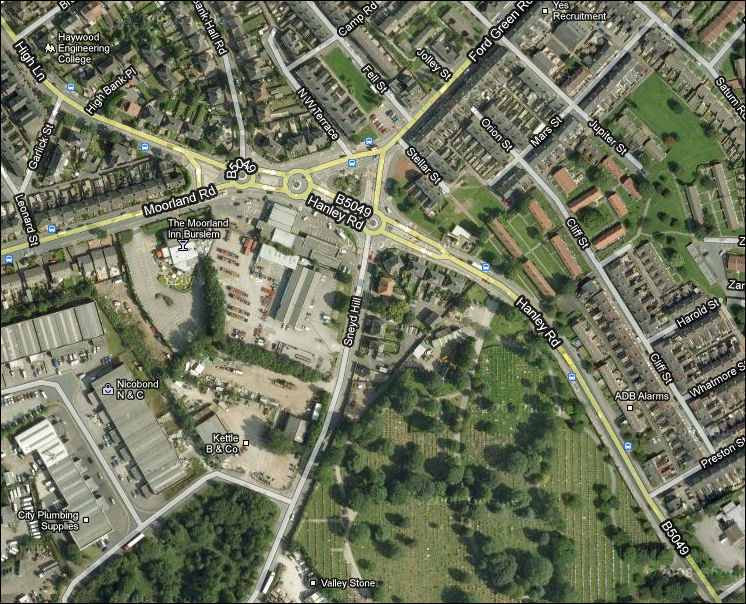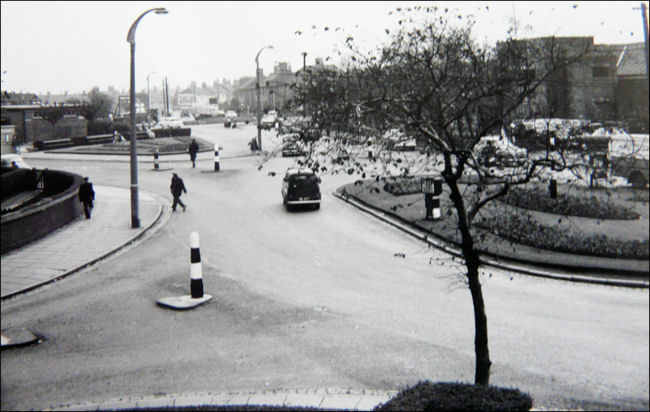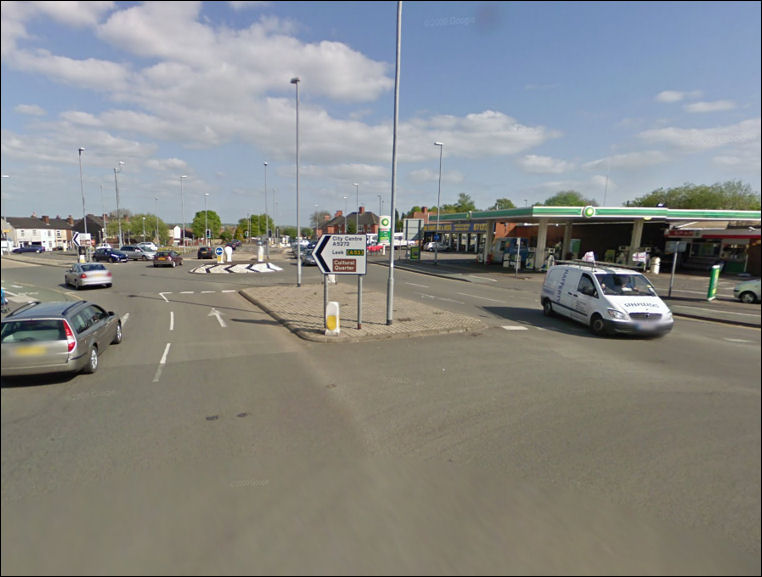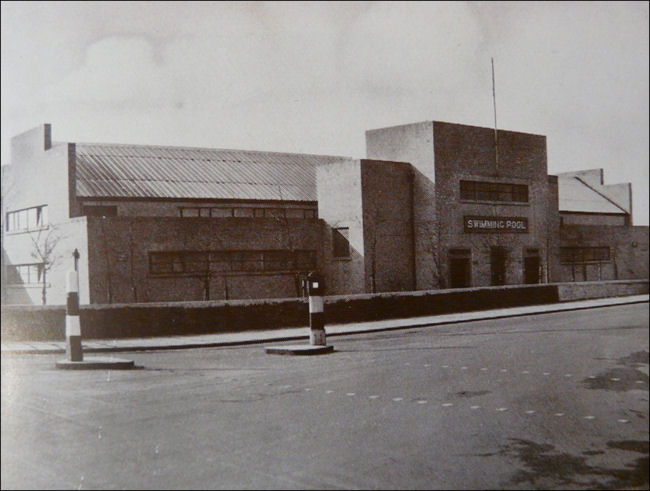|
Smallthorne - ‘Smothern Rindabite’
- the Devil’s Islands
A mile east of Burslem town centre stands the most perplexing and bewildering location in Stoke-on-Trent. It’s a place where you could fit the whole of Burslem’s Market Place, the Town Hall, the Queens Theatre and Ceramica into its boundaries. But, if you think Ceramica is a bit of a puzzle, it’s nothing compared to this setting.
I’ve heard it called Spaghetti Junction and Devil’s Island. And it’s cursed at peak times each day as drivers submerge their vehicles into its labyrinthine thoroughfares hoping to get out the other end unscathed. Irritation, frustration and the repetitive sound of car horns on the bumper-to-bumper, avoid-collision-at-all-cost merry-go-round, is the order of the day.
But if drivers think they’ve got it bad it’s even worse for pedestrians as they dazedly wander around hoping to find the right exit to reach their intended destination. It is also said that some travellers have been so confused that their journey has been extended by more than an hour after taking the wrong road finishing up in Norton instead of Chell. This is a place disfigured with all manner of vitriolic labels; but to most local users this hideous junction is known simply as ‘Smothern Rindabite’.
In truth it’s not even a roundabout. Ever since the most recent attempt to resolve the historic congestion of this improbable junction, three baby roundabouts have been inserted to control the six roads leading into the crossroads. To this mixture seven pedestrian-controlled crossings and one rather pointless ornamental island – sponsored I’m sure with unintended graveyard humour – by Arlington Funeral Services, have been added. Well, there you have it, and you have to smile don’t you?
Of course humour is what this part of Smallthorne is all about. For starters this erstwhile hamlet was chewed out of the rural side of a pleasant hill to accommodate the worst ravages that heavy industry could heap upon it – coalmines, potbanks and chain works. Even today, after years of demolition and change, this idiosyncratic jumble standing high above the communities of Burslem and the real village of Smallthorne, still has an industrial feel about it, but it is only a faint whiff of the great aroma that once pervaded the district.

Smallthorne roundabouts -
Google map 2010
Businessman Tony Tabbinor acutely remembers the time when structural changes affected his family. Tony’s family had lived on the main road at Nettlebank, near to the roundabout, since his birth. In 1968, when Tony was 21, the council had already given notice that this delightful row of mid 19th century worker’s cottages was to be demolished.
“I was under the impression that they were going to be knocked down starting from the Hanley end of the road, a couple of miles away,” remembers Tony. “Anyway I was having my Sunday lunch in a Burslem pub when someone told me that the council had begun pulling down the houses in Hanley Road and I commented that they wouldn’t reach our house for some time yet.
To my shock my informant declared that they had actually started from Smallthorne end just now. Our house was the fourth one along so I dashed home just in time to see the house where I was born collapsing before my eyes under one heavy blow from the contractor’s steel ball. I mean, can you imagine, I go out for my lunch and when I return my home had gone!”
Of course there is a slight exaggeration to Tony’s tale, but it all adds to the flavour of the story.
Nettlebank at the time he is talking about, then formed part of a coal wharf that served Bellerton Colliery at Norton as well as the lower village pits, a place where Tony’s mother could only hang out washing on Sunday when the wharf was shut.
As a child Tony remembers the steam engine from the Bellerton pit arriving at the wharf. “The engine would pull up the steep hill and I’d watch it as I set off for school chugging all the way up. It was so slow with its heavy load that I sometimes wondered if it would reach the top. You could actually walk faster than the engine.”
By the late 1960’s Smallthorne had seen many changes caused by industry. But housing development was occurring at such a rate that the rural landscape was being transformed week by week.
As a boy Guy Barks arrived in the village just before the General Strike began in 1926 when his parents moved here. He remembers that the end of his terraced street gave way to miles of rolling fields all the way to Milton.
“Of course they weren’t real fields,” says Guy with parochial emphasis. “They were acres of grassed-over opencast collieries and waste tips. I can still recall the whole aspect looking like an anthill during the miners’ strike with thousands of people crawling around scavenging for a bucket of waste coal. It was poverty and social inequality that influenced my father to become active in politics, and in the 1930’s depression my mother fed miner’s families from our backyard which she turned into a community soup kitchen.”
Ford Green Road was then named Leek Road and at the bottom of the hill was Chain Row laid out so that infinite lengths of steel chain could be strengthened by gangs of men working in teams on each link. Guy Barks, a man who somehow injects irony into his every sentence says,
“I bet you didn’t know that the chains for the Titanic were made in Smallthorne?” I didn’t and I was truly surprised. “It was the longest stretch of chain ever assembled, and probably the most useless exercise that ever was seeing that it only lasted a few days before the ship sank to the bottom of the North Atlantic.”
Guy evokes memories of old craft industry when, walking back from Milton with his late father, Alderman Horace Barks, he stood to watch men from Smallthorne ironworks tipping hot slag onto the great mound of debris. “It was electric,” he recalls, “Huge golden balls of hot metal tumbling like red stars out of the night sky – stupendous!”

Smallthorne Roundabout
looking towards Hanley direction
to the left the
public toilets and to the right the swimming baths
photo: Fred Hughes

Smallthorne Roundabout -
Google Street View - 2010
Hilda and Gerald Ansell make their home right next to ‘Smothern Rindabite’ and they have lived at the side of this traffic conundrum for 60 years. Is it better these days than it used to be, I wondered. “Not really,” says Gerald casually. “It’s one of those locations that will always be a bit of a hot spot. Once there was a big roundabout with a lawn in the centre. That strange island that’s in the middle is all there’s left of it and it used to have a public lavatory on it, but of course that was before traffic increased to prohibit access to it.”
In my minds-eye I had the impression of little old ladies caught short, and cross-legged men standing at the pavement’s edge contemplating whether to dare to cross through the solid continuous waves of cars and buses or whether to hold-out till they get home. “You should never get caught out on the wrong side of the street at ‘Smothern Rindabite’,” advises Gerald. But that’s all in the past now that the public loos have gone.

the Olympic-size open-air swimming pool
at Smallthorne
Gerald and Hilda also remember the Olympic-size open-air swimming pool erected on the west side of the road occupied these days by a filling station. Imagine this extravagance if you can. At the height of industry in a time before the Clean Air Act was introduced: Smallthorne and Burslem skies filled with cloaks of black smoke and with choking dust trapped between Sneyd Colliery, Bellerton Colliery and the ironworks, not to mention the thousands of potbank chimneys spewing anthracite-black smoke into the atmosphere. Get the picture?
And so, what do the colliery owners do? Well they enterprisingly build a state of the art open air swimming pool with sun-bathing sections and underwater observation chambers. Now that’s innovation for you – or is it folly; for within a few months the pool was shut down, something to do with subsidence they said at the time as swimming pool water began seeping away. And perhaps it might have had something to do with swimmers coming from the water dirtier than when they plunged
in.
In the 1960s the miner’s representatives had another go at using the site when they built the finest welfare club in Stoke-on-Trent on the land that they cleared of that aquatic tomfoolery. Many famous variety acts appeared here when it was known as the Wolstanton Colliery Club and Institute.
But with the decline of the club and institute format the premises were acquired by the partnership of the then world’s men’s darts champion Eric Bristow and the Women’s world’s darts champion Maureen Flowers. They called it the Crafty Cockney, the name by which Bristow was nicknamed when he stood at the oche during dart’s championship matches at Jollees nightclub in Longton.
It was a huge success, but perhaps too successful. In fact the location was all wrong what with fierce traffic and residences in close proximity. As a consequence the management came up against the police and the local authority over supervision and anti-social behaviour.
“Living next to it was awful,” Hilda Ansell told me. “Every night there were disturbances. Even murder was committed here – right outside our front door when a doorman was shot dead.”
And so once again the land-use changed and today (2004) a modern Harvester restaurant, the Moorland Inn, has become a popular mealtime venue.
When I was a boy ‘Smothern Rindabite’ was the gateway to the countryside. Walking up the hill from the blackness of Burslem you could see for miles to the east and reach out and nearly touch the rugged outcrop of moorland rocks called the Roaches that were fretted against the distant skyline.
The vales and peaks were inspirational, places to aim for to clear the eyes and lungs of industrial pollution. Ah, but then there was no traffic congestion, just an occasional Morris Oxford and the frequent horse drawn cart calling at Nettlebank’s blacksmith shop, and the ribbon of smoke from the slow engine pulling its load up the bank to Nettlebank wharf.
Fred Hughes
Further personal recollections of Smallthorne Roundabout by Stanley Moulson
Retired personnel manager Stanley Moulson spent his childhood in a most interesting neighbourhood.
“I lived at Smallthorne Roundabout in High Lane, one of the busiest road junctions in the Potteries,” he begins. “The years I remember are between 1936 and the late 1950s. It was almost rural then. Yet you wouldn’t think of one of the most complicated junctions in the Potteries as being a traditional settlement. But it was quite a tight-knit community.”
But, I say, to call it a roundabout is a bit of a misnomer isn’t it?
“I remember two distinctive roundabouts,” Stanley recalls. “There was a large oblong-shaped one at the top of Moorland Road and a smaller circular one at the top of Sneyd Hill. Then there was a triangle at the top of Ford Green Road which had a public toilet sited on it. The roundabouts were a marvellous attraction by themselves. People would come just to take pleasure in looking at the gardens on them for each enclosure was landscaped with lawns, seasonal shrubs and flowering plants and tended weekly by the City Parks Department.”
Literally hundreds of acres of Stoke on Trent were made up of similar green plots. It was the job of teams of in-house trained gardeners and their apprentices to keep the countless parks, cemeteries and public spaces in tip-top condition. And each squad jealously competed for the best laid-out plot.
“Smallthorne Roundabout was typical of many oases,” continues Stanley. “There was pride in the roundabout gardens that shone through the blackness and pollution. Proper paths were cut across each roundabout to reach the centre where magnificent sculptured cast iron lampposts towered above the roads. Pendant lamps enclosed in glass chandeliers gave off sufficient incandescent light to illuminate the crossings, even lighting up the rooms of the nearest houses.”
Nowadays the roundabout gardens have been removed to accommodate traffic. Gone also are the astonishing open-air swimming baths that stood on land now occupied by a petrol filling station and a gastro-pub.
“Memories of the baths, the jewel in the crown of Smallthorne, are still fresh,” says Stanley. “It was a wonderful building with art deco features that occupied the whole position from Moorland Road to Sneyd Hill where the boiler-room and pumping house stood. You could hear the rumble of water being heated so the temperature could be maintained all year round.
At the back you could get a good view of the sun terraces where people would lounge under reflective glass in the shade away from the wind and weather. The terraces were semi-circular and edged with a glass wall rising to thirty-feet. These terraces were tiled and could accommodate 2,000 spectators. The pool was made to Olympic proportions with international diving boards. And beneath the level of water was a restaurant with windows through which diners could watch the swimmers from observation chambers.
It’s a pity the baths didn’t survive. Had it done then it would have totally changed the way Smallthorne Roundabout is today.”
“During the war the baths were used as an auxiliary fire station,” says Stanley, “Some prefabricated huts were put up for the staff where Birchendale furniture store is now (2005). These huts were occupied by squatters straight after the war due to the serious shortage of housing. All that was left was the shell of the baths which was finally demolished in the early 1960’s.
On Sneyd Hill there were some garages built into the baths where a lock-up shop known locally as, the ‘Little Wooden Hut’ stood. The owners were Mr and Mrs Coates who sold confectionary. I knew little of luxuries like sweets and ice cream because of wartime restrictions. One day my mother announced that the ‘Little Wooden Hut’ was going to sell ice cream again. The day arrived and I joined a queue for my first taste of Lyon’s Maid handed to me in a cardboard tub from a metal box that the shopkeeper called a fridge.”
It’s quite surprising the way Stanley describes Smallthorne Roundabout as a community. But he fills his images with other contemporary residents.
“A service garage stood where BP filling station is today owned by somebody called Eaton,” he recalls “The police station was a council house, number 271 Moorland Road. Two doors away were the district nurse and midwife, a woman name Nurse Mitchell. There were tiny coalminer’s houses between North West Terrace and Fell Street that reminded me so much of dolls houses.
By Ford Green Road and Hanley Road was a smithy’s forge where horses were shod amidst a flush of sparks and the sound of hammer on anvil. It was a place full of colour and excitement and metal smells. Another memory I have is of an imposing corner shop owned by the Till family. The interior was very old fashioned with wooden cabinets and glass fittings. It was demolished in the late 1960s and even then it was still lit by gas that flickered evocatively on dark nights.”
Thanks to Stanley my journey through Smallthorne Roundabout will never be the same again.
Stanley Moulson

|
![]()
![]()
